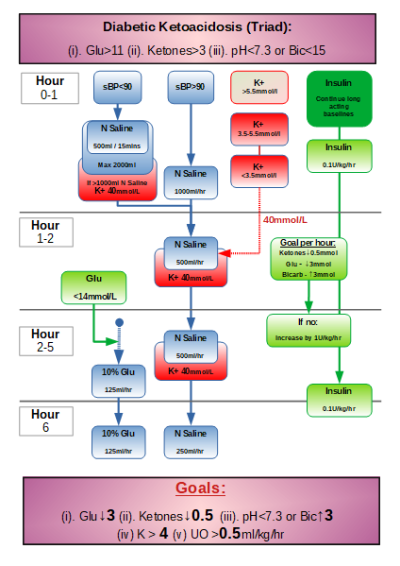Table of Contents
Diabetic Emergencies
DKA
Diabetic Ketoacidosis is a Triad
- ketonaemia: ++ urine or >3mmol/l
- hyperglycaemia: >11mmol/l
- acidaemia : pH<7.3 or bicarb <15mmol/l
Characterisations
- typical losses
- water: 100/kg
- Na+: 7-10mmol/kg
- Cl-:3-5mmol/kg
- K+: 3-5mmol/kg
Pathophysiology
- Insulin deficiency, increased insulin counter-regulatory hormones (cortisol, glucagon, growth hormone, and catecholamines), and peripheral insulin resistance lead to hyperglycemia, dehydration, ketosis, and electrolyte imbalance
- increased lipolysis and decreased lipogenesis, abundant FFA's are converted to ketone bodies: β-hydroxybutyrate (β-OHB) and acetoacetate.
- Hyperglycemia-induced osmotic diuresis causes dehydration, hyperosmolarity, electrolyte loss, and subsequent decrease in glomerular filtration rate
- reduced renal function leads to reduction in glycosuria and hyperglycemia worsens
- impaired insulin action and hyperosmolar hyperglycemia leads to reduction in K+ uptake by skeletal muscle
- hyperosmolarity causes efflux of K+ from cells leading to intracellular K+ depletion and loss of K+ via osmotic diuresis
Controversies in management
- Arterial or venous measurements - difference between venous and arterial pH is 0.02-0.15
- blood ketone measurement - whilst high levels of ketones might not give consistent results,these levels are still well above the levels needed to diagnose and manage DKA
- Colloid versus crystalloid - critical care consensus suggests that colloids should be avoided where possible due to a potential risk of increased mortality and morbidity
- Rate of fluid replacement - concern that rapid fluid replacement may lead to cerebral oedema in children and young adults, hence caution in this group
- 0.9% sodium chloride vs Hartmann’s - no agreement but saline generally used with added K+
- Continuation of long-acting insulin analogues and basal human insulins - avoids rebound when IV insulin is stopped
- Fixed-rate IV insulin infusion (FRIII) versus variable rate IV insulin infusion (FIII is current standard)
- Initiating treatment with a priming (bolus) dose of insulin - unnecessary
- IV bicarbonate - Excessive bicarbonate may cause a rise in the pCO2 in cerebrospinal fluid (CSF) and may lead to a paradoxical increase in CSF acidosis. IV bicarb may delay fall in lactate:pyruvate ratio and ketones. Some suggestion that Bicarb use may be implicated in cerebral oedema young patients.
- Use of intravenous phosphate - no evidence of benefit in replacing quite significant losses unless signs
- rate of glucose lowering - low dose insulin infusion appears to lower glu at similar rate to high dose IV infusion once used.
Complications
- hypo and hyperkalaemia
- hypoglycaemia - if not watched and fall in Glu is monitored. Rebound ketosis driven by counter-regulatory hormones may result
- cerebral oedema - uncommon in adults
- Iatrogenic vs present before?
- Especially in children
- Especially if Bicarb given
- pulmonary oedema - rare
- iatrogenic
- Especially in elderly and those with cardiac dysfunction
Management
Underlying causes must be at the forefront of examination and investigation.
Baseline investigations:
- electrolytes, Full blood, Lactate, VBG, Glu, urinalysis
Further Ix depending on likely cause:
- stool MCS, urine MCS, blood cultures, CXR, CT
Treatment strategy (see diagram):
- N saline - fluid of 1st choice and rate is dependent on initial sBP and response
- Insulin - baseline long acting insulins will continue but a constant, fixed rate IV infusion is the mainstay of treatment, only altering if poor response to hourly goals. Insulin commences after fluid resuscitation commences.
- K+ replacement - generally not in 1st hour but then according to value. Must be above 3.3 before insulin commences
- Fluid management and management of ketosis and Glucose control are central to recovery.
- Fluid management pathways are a baseline. A proper assessment of fluid status requires a thorough examination
- ECF volume assessment is based on physiological signs - HR, BP, UO, CVP etc
- UO should exceed 0.5ml/kg/hr
- TBW is assessed biochemically - osmolarity, Na+
- reviews must be carried out regularly, hourly at 1st, to assess progression of recovery and to alter management if needed.
- Ketosis should reduce at rate: 0.5mmol/L/hr
- Bicarb should rise at rate: 3mmol/L/hr
- Glu should fall at rate: 3mmol/L/hr
- urinary catheter and CVC lines may be required
- address precipitating factors
- conversion to appropriate subcutaneous insulin when biochemically stable (blood ketones less than 0.6mmol/L, pH over 7.3)and the patient is ready and able to eat.
management-of-dka-241013.pdf
condensed_adult_diabetic_ketoacidosis_dka_management_chart_aug_2017.pdf
dka_and_hhs_prescription_jbds_april_2018_.pdf
Jt Brit Soc Diabetes guidelines DKA 2021
